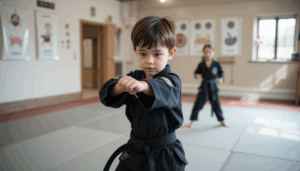This article was last updated on August 04, 2025

Watching your little one go from a tiny baby to a busy kid is an amazing journey. They go from simple baby moves to doing complicated stuff really fast. Raw and wow, right? One key to all this growing is a thing called bilateral coordination. Sounds like a big word, but it’s pretty much how well kids use both sides of their body together. And it’s more than just being quick; it helps with brain stuff, like thinking and learning.
What’s This Bilateral Coordination Thing?
Bilateral coordination means using both sides of the body to do things at the same time. Like when you’re jumping up and down (symmetric moves), or when you’re cutting a card and holding it with scissors (asymmetric stuff). One important thing is when they reach past the middle line down the center of the body.
The Brain’s Part: The Corpus Callosum Pathway
Right in bilateral coordination is this part in your brain called the corpus callosum. It’s like this fat bunch of tiny brain wires that connect the left and right sides of the head. It lets them talk to each other, and that helps with moving and feeling. Babies start using both fingers all mixed-up. By age 3–4, kids pick a favorite hand, and by age 5–6, they get the hang of reaching across sides.
Developmental Milestones:
- 0–2 years: Uses both hands mostly equally.
- 3–4 years: Begins showing hand preference.
- 5–6 years: Masters midline crossing for complex tasks.
(Source: American Academy of Pediatrics)
Beyond Makeshift Movement: Sensing Where You’re At
Bilateral coordination blends with proprioception, which is being aware of where our body parts are around us. Besides movement and routine, we also lean on balance. The vestibular system helps with feet and moves. It lets both body sides work together for skills like passing, rolling, or climbing walls. This builds stability and confidence throughout the day.
The Ambidextrous Misconception
Children appearing “ambidextrous” beyond age 5 may actually struggle with bilateral coordination. This isn’t advanced dexterity — it’s often a sign of poor interhemispheric communication. They might switch hands a lot when they write, not cross the middle line, or seem clumsy. Early intervention is really important to stop academic and self-care problems from popping up.
Why Midline Crossing Matters for Learning
Visual tracking (essential for reading) relies on midline crossing. A child unable to smoothly track words from left to right may struggle with reading fluency. Similarly, writing requires controlled cross-body movements. Research shows bilateral coordination deficits correlate with difficulties in:
- Handwriting legibility
- Organizing work on a page
- Participating in sports
(Reference: Understood.org)
How Martial Arts Supercharges Development
The Inspire Martial Arts program, designed by Chris Gehring, leverages neuroscience to transform child development. Unlike generic activities, its age-specific drills target bilateral coordination through purposeful play:
- Preschool Kids (3–5 years): Animal walks like crab crawls, simple obstacle courses, and jumping to music help cross-body coordination.
- Kids Early in School (5–7 years): Games like “knee-tags” (touching opposite knees) help learn crossing the middle.
- Older Kids: Trickier moves like boxing training build balance and reaction timing.
These fun daily games get both sides of the brain talking to each other, making the middle brain bit stronger. What happens? Kids get better at moving, paying attention, and coming up with solutions.
The Science in Action
Studies confirm that bilateral exercises enhance neural connectivity. A 2020 review found martial arts improved executive function in children by 15–20%.
(Source: Journal of Sports Science & Medicine)
Empowering Parents: What You Can Do
Understanding the science empowers families to nurture growth:
- At Home: Play “Simon Says” using cross-body moves like “Touch your left ear with your right hand.”
- Sensory Fun: Try using clay, climbing mini-walls, or swimming to get both hands moving.
- Work Together: Team up with teachers or therapists if delays are suspected.
Inspire: Where Martial Arts Meets Neuroscience
At Inspire Martial Arts in North Royalton, every drill is rooted in developmental science. Parents might see a fun class, but behind the scenes:
- Made-Up Progress: Things change as kids grow through each stage.
- Whole-Kid Look: Builds self-belief, habits, and movement skills.
- Real Outcomes: Graduates show improvement in focus, fine motor skills, and school readiness.
“Our drills aren’t random they’re neural workouts. We’re building brains as much as bodies.”
Chris Gehring, Inspire Program Founder
Ready to Unlock Your Child’s Potential?
Using both hands well is a big step for kids. By mixing brain science and fun games, Inspire Martial Arts gives a cool path for full learning.
Visit us in North Royalton to see the difference science-based training can make:
Inspire Martial Arts North Royalton
References
- American Academy of Pediatrics on developmental milestones:
HealthyChildren.org - Understood.org on bilateral coordination challenges:
Understood – Bilateral Coordination - Journal of Sports Science & Medicine on martial arts and cognition:
JSSM Study Review






